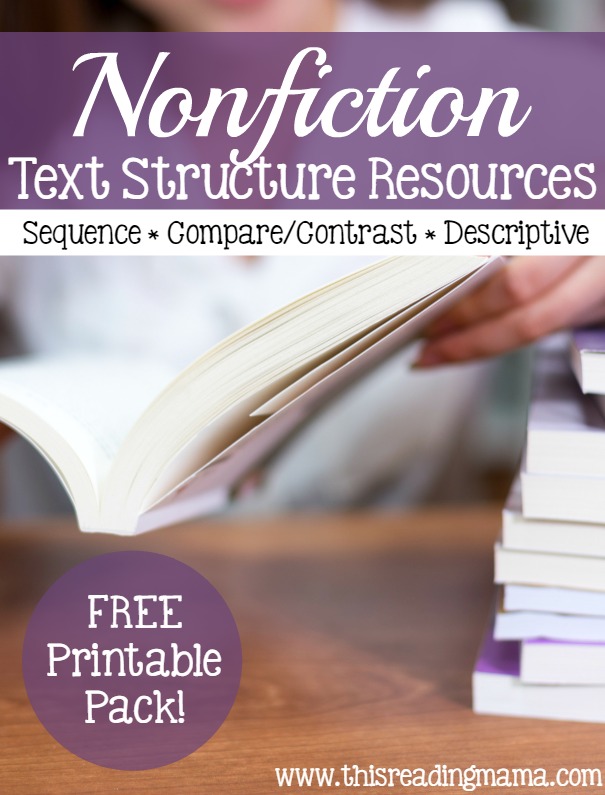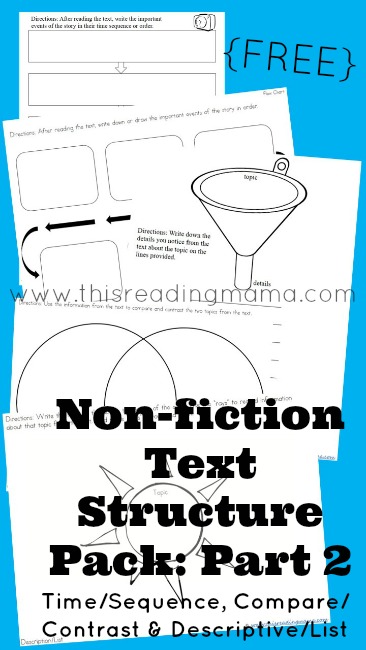
Welcome back to 5 days of Teaching Text Structure to Readers, a part of iHomeschool Network’s January Hopscotch! So far this week, we’ve talked about the importance of text structure and I’ve shared some free goodies and tips for fiction and non-fiction text structure. To read more about this series, please read the introductory post or click on the image above.
Today, I want to spend a little more time with non-fiction, as I share another important step of teaching text structure. I will also share another pack of FREE graphic organizers for time/sequence structure, compare/contrast structure, and descriptive/list structure.
Using Text Structure to Summarize Text
While it is wonderful that students can identify and defend their position on which text structure has been used with a text, I don’t want my readers to stop there. That’s where all these free graphic organizers I’m sharing this week come into play. Readers use the graphic organizers to fill out information from the text. But not only that. Readers need to be able to take the information they’ve filled in and use it to summarize the text. This is not as easy for many readers as one may think!
Model How to Summarize Text
It is vitally important that kids hear you summarize. Be explicit as you do it. For example, when summarizing the section that compares whales and sharks, make sure you include information in your summarization about how they are same and how they are different. Say things like,
Did you hear that when I summarized the text, I included both similarities and differences? If I had just shared the differences in my summary, I would have left out important information that the author wanted me to understand…that whales and sharks are similar AND different.
Pick the Best Summary
Once I have modeled using the text structure (many times) to summarize the text, I like to play a little game with readers I call, Pick the Best Summary, to start the process of turning the summarizing over to them. Below is an example I used with Why is a Frog Not a Toad? by Q.L. Pearce. (This is a GREAT text for the Compare/Contrast text structure.)
- I read aloud the introduction and one of the sections called, Why is a Bee Not a Wasp?
- After reading my section, I used a Venn Diagram (included in the free download below) to record the similarities and differences between bees and wasps, based on the text.
- After filling in my Venn Diagram, I read aloud three pre-written summaries. I asked my student to follow along as I read each one (Note: I typed up and printed all three summaries and read them aloud, so that the reader could follow along.) and help me decide which one was the best summary for the text structure used (compare/contrast) in the passage.
- I paused after each summary and we had some discussion over the good parts of the summary and the parts that were left out.
Summary 1 (only focuses on similarities; does not include differences)
Honeybees and yellow-jackets wasps are the same in many ways, so many times people confuse the two. They both have similar body shapes and sizes. They both collect nectar from plants. They both build large colonies and structures to protect their eggs. The smaller building blocks of their hives are made of little hexagonal (or six-sided) shapes. They also both have stingers, which they use to attack their prey. Because honeybees and yellow-jacket are so similar, it’s easy to see why people confuse the two so much.
Summary 2 (the best choice from the three summaries; it includes similarities and differences)
Honeybees and yellow-jacket wasps are the same and different in many ways. They both have a similar size body, so they are often confused for one another. They both collect nectar from plants, although they do this in different ways. Even though their nests are made differently, they both build structures made up of little hexagons to protect their eggs. A wasp has a straight stinger and can sting its prey over and over again, but a bee has a barbed stinger, which can be used only once on its prey; then it dies. So while honeybees and yellow-jacket wasps are very similar, there are several differences between them.
Summary 3 (based on a problem/solution text structure and misses the structure of the text altogether)
Honeybees and yellow-jacket wasps are very similar to each other. This is a problem because people confuse the two all the time. This problem could be solved if people would educate themselves on the differences between the two insects. Here are some ways they are different: bees and wasps build different looking nests or hives, a wasp’s body is smoother looking, they get nectar from plants in different ways, and a bee stings once, then dies; while a wasp can sting over and over again. Understanding these differences would help people not to confuse the two.
Once readers are able to critically think through summary examples and pick the best one, it’s time to ask the reader to give it a go. Good summaries do take A LOT of practice. Like a reader mentioned this week, some adults don’t summarize all too well. Asking students to write their summary can be explored, but I’ve found that young readers, especially reluctant and struggling readers, do better with oral summaries. Writing the summary is a slower process and can interfere with comprehension and the thoughts of the reader.
Non-fiction Text Structure Pack: Part 2
In this pack, you’ll find organizers for the text structures of Time/Sequence, Compare/Contrast, and Descriptive/List. Use them not only to ask students to record the important information about the text, but as a springboard for summarizing! To download this pack, click HERE or on the image above.
Stay tuned for Day 5. I am tickled pink that Emily Kissner will be guest posting for me! If you have older elementary students and you are struggling with text structure or literacy in general, you will WANT to follow her blog! I could sit and read it ALL day. Seriously. It is a gem.
Enjoy teaching!
~Becky

Thanks for this– my 2nd grade class is studying non-fiction text right now.
I am loving this series and learning a lot from it. I wish I had more time to work on summarizing with my daughter – I can only hope that she is learning it in school and will understand the text structure’s impact on her summaries.
Fabulous resources. Thank you so much. I can’t wait to use them with my students.
You’re very welcome! Thank you for stopping by to comment.
Thanks so much for sharing your resources!! Just what I have been looking for!!
Thank you for sharing such a wonderful resource!
You’re welcome! 🙂
Thanks so much for the Fiction and non-fiction forms. They will really help during Distance Learning 😁